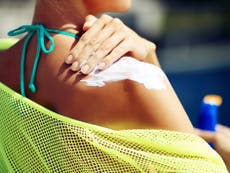A viral photo of a 92-year-old woman’s neck becomes reminder to apply sunscreen everywhere
‘A not so gentle reminder on the importance of sunscreen’

Your support helps us to tell the story
From reproductive rights to climate change to Big Tech, The Independent is on the ground when the story is developing. Whether it's investigating the financials of Elon Musk's pro-Trump PAC or producing our latest documentary, 'The A Word', which shines a light on the American women fighting for reproductive rights, we know how important it is to parse out the facts from the messaging.
At such a critical moment in US history, we need reporters on the ground. Your donation allows us to keep sending journalists to speak to both sides of the story.
The Independent is trusted by Americans across the entire political spectrum. And unlike many other quality news outlets, we choose not to lock Americans out of our reporting and analysis with paywalls. We believe quality journalism should be available to everyone, paid for by those who can afford it.
Your support makes all the difference.A picture showing the physical effects of UV rays has gone viral as a reminder to apply SPF to everywhere on the body, not just the face.
A New York-based dermatologist took to Twitter earlier this week, where he shared a photo of a 92-year-old woman who had used UV protective moisturisers on her face but not on the neck for the past 40 years. Since the tweet was posted on 1 September, it has garnered more than 236,000 likes and 42,000 retweets from people reminding others of the importance of sun protection.
In the close-up image, there is a clear difference between where the woman has applied SPF to her face, versus the places where she has missed her neck. Her neck shows signs of skin damage, while her cheek has been protected from UV rays.
Along with the tweet, Dr Avi Bitterman also attached a link to an October 2021 study on “Ageing research: rethinking primary prevention of skin cancer,” where the 92-year-old woman had been used as a case study. Published in the Journal of the European Academy of Dermatology and Venereology, the paper studies the connections between ageing, skin cancer, and UV protection.
“The best advert for SPF ever!” one user tweeted in response.
“A not so gentle reminder on the importance of sunscreen,” said someone else.
Some users reminded others to not just apply sunscreen to the face and neck, but the hands and chest as well.
“I tell people all the time that one of the biggest giveaways for aging skin is the neck but also THE HANDS & THE CHEST!” one Twitter user said.
“From the forehead to the chest people!!!” a second person wrote.
Others explained how wearing sunscreen isn’t the only way to protect the skin from damage caused by UV rays. Retinol is a form of vitamin A that stimulates cell turnover, collagen production, and reduces the appearance of fine lines and wrinkles.
“Don’t forget to put ‘retinol’ on your neck tonight,” tweeted one user. “Use AHAs, antioxidant creams. Hand creams (always keep your hands moisturized) and put sunscreen on your neck, chest, hands and feet. The neck, chest, hands and feet show signs of aging fast.”
While ageing is a natural part of life, there are many measures that can be taken to prevent the skin from premature ageing or damage. Not only has sunscreen been found to protect the skin from the sun’s rays, but daily sunscreen use can also help avoid the development of wrinkles and age spots.
There are three forms of UV (ultraviolet) rays – a form of electromagnetic radiation which comes from the sun – that can potentially lead to skin damage, according to the American Cancer Society. When it comes to UVA, UVB, and UVC rays, the first form emits the least amount of energy and causes the skin to age.
UVB rays emit more energy than UVA rays, and can cause direct damage to DNA in the skin cells, resulting in sunburn. UVB rays are also responsible for the majority of cases of skin cancer. UVC rays emit the highest amount of energy out of the three UV rays, but this form of radiation does not reach the earth’s surface because it is blocked by the ozone layer in the atmosphere.
SPF, also known as sun protection factor, measures the amount of protection a sunscreen can provide against the radiation from the sun. When buying a sunscreen, the NHS recommends purchasing one with an SPF of at least 30 to protect against UVA and UVB rays.



Join our commenting forum
Join thought-provoking conversations, follow other Independent readers and see their replies
0Comments